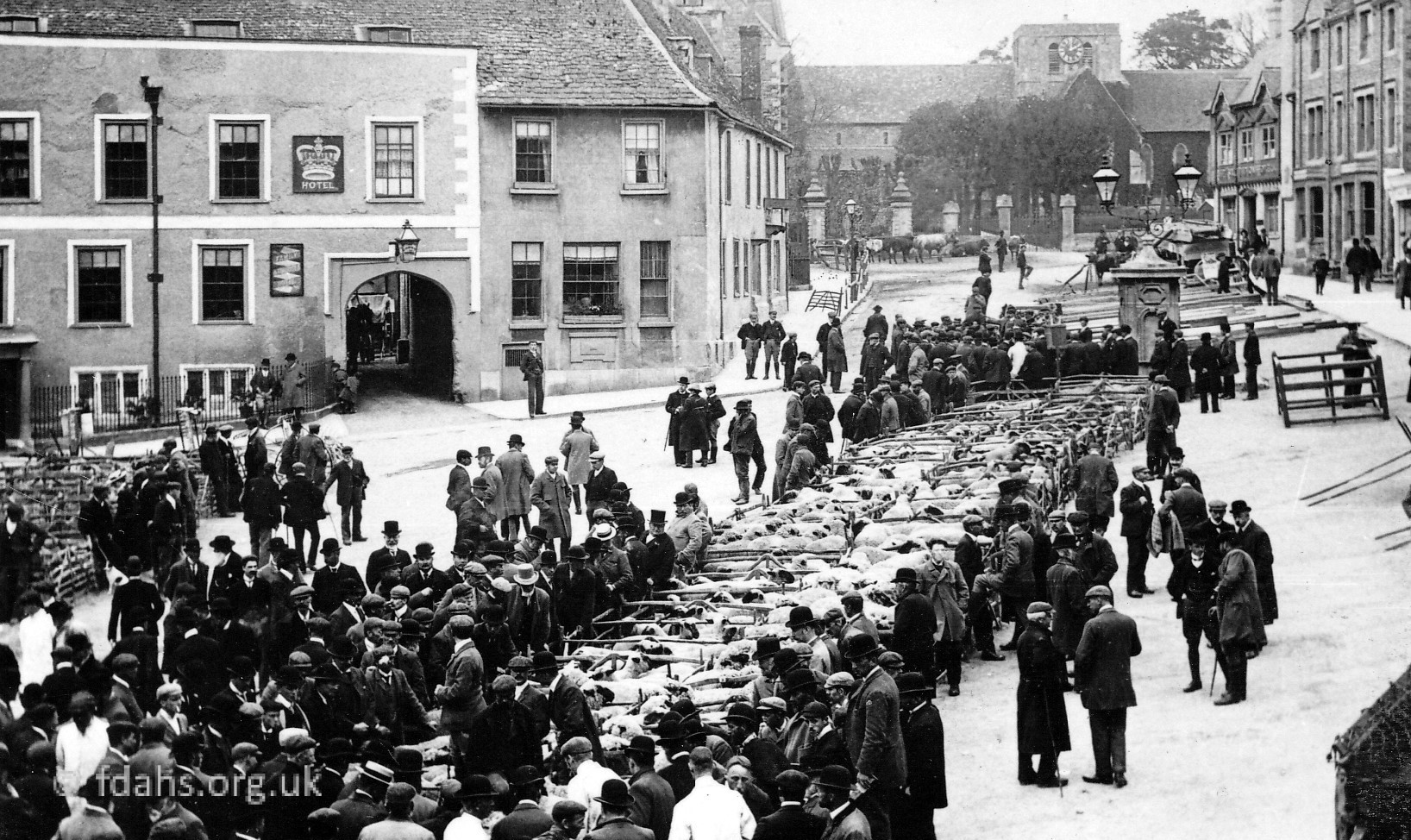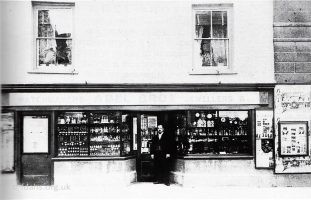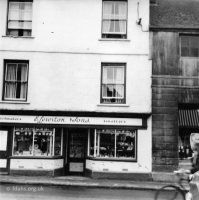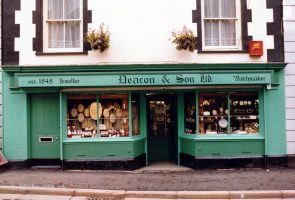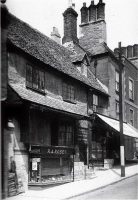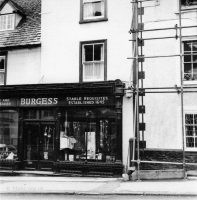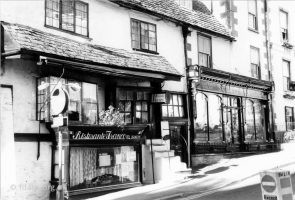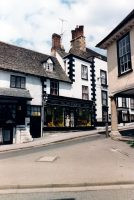More Photographs & Further Details
More photographs and information about the shops and other businesses in Faringdon Market Place. The photographs of premises shown here have been scanned in from the original photographs given to the Society over the years and stored in the Society’s archives. The numbers given for each property mentioned correspond as accurately as possible to the postal addresses and are shown on the adjacent map.
An occupational history of each premises, as far as is known, can be found on the ‘Shops & Businesses in the Market Place‘ page. There is also a ‘Market Place Street Views‘ page that contains general information about the Market Place and may contain further details on the premises shown in the photographs, and a page specifically about ‘Faringdon Market‘.
Faringdon Market Place in the 1900s
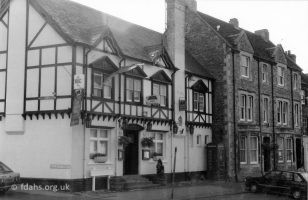
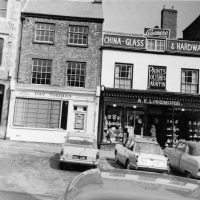
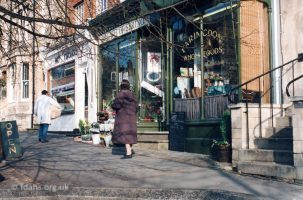
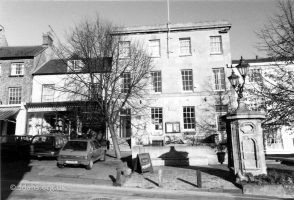
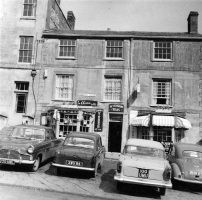
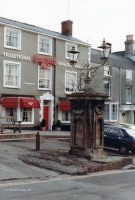
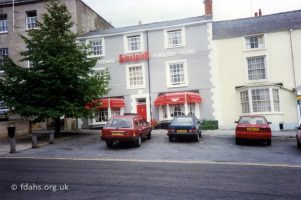
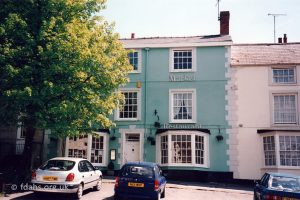
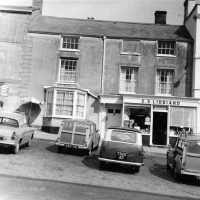
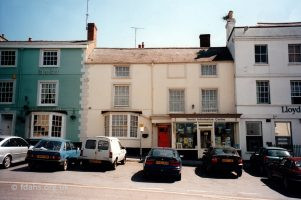
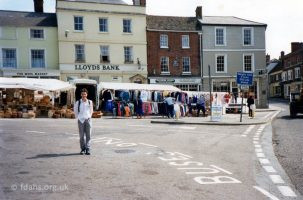
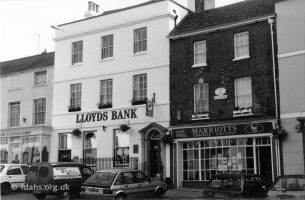
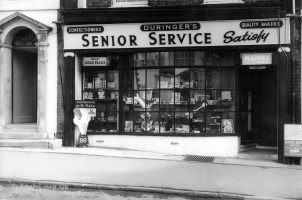
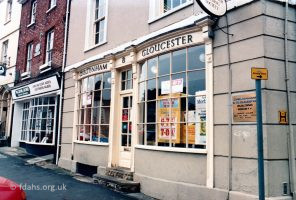
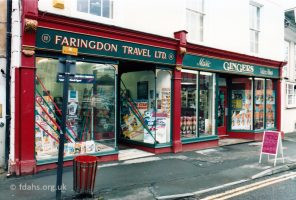
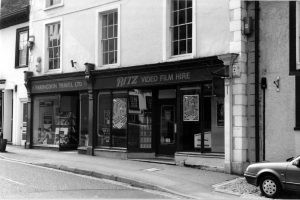
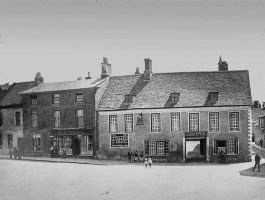
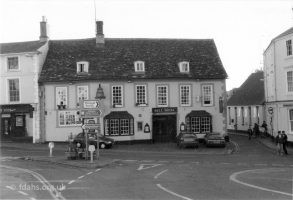
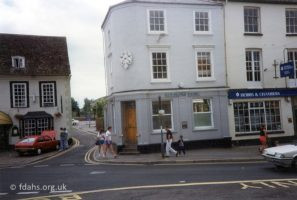
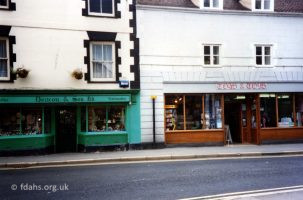
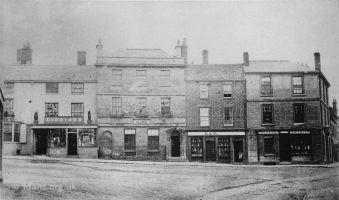 c1880s. From the left is #7 George Ernest, grocer and bacon curer; #7a Liddiard, grocer; #8 the County of Gloucester Bank; #9 Lay, baker and confectioner; #10 Cooper, Chymist. On the far right is the start of London Street.
c1880s. From the left is #7 George Ernest, grocer and bacon curer; #7a Liddiard, grocer; #8 the County of Gloucester Bank; #9 Lay, baker and confectioner; #10 Cooper, Chymist. On the far right is the start of London Street.
Henry Lay (1815-1879) was born in Highworth and by the age of 25, he was living in London Street and become a baker and confectioner. Soon after he married local girl Eliza Judd (1822-1897) and by the age of 51 had 5 daughters and 6 sons. He took over the shop at 9 Market Place during the 1850s. In 1869 he bought a shop in the little town of Swindon, now expanding since the arrival of the Great Western Railway. He died ten years later and his young daughter Eliza Emily Lay (1858-1914) continued to run the shop in Faringdon. Employed there as a pastry cook was a young man called George Stafford Willis, born in Malta, and they were soon married. Hence, at some time later in the next century the shop was renamed Willis.
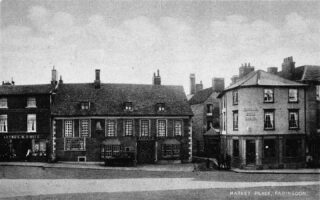 1926. Turning to the right, across the start of London Street and looking at The Bell. #11-12 Market Place on the left was Arthur W. Smith (draper), which was taken over by Noel R. Wilkes in 1927. To the right of The Bell and the start of Southampton Street is #14 which used to be Pocock & Son (tailors) but this year taken over by Barclays Bank.
1926. Turning to the right, across the start of London Street and looking at The Bell. #11-12 Market Place on the left was Arthur W. Smith (draper), which was taken over by Noel R. Wilkes in 1927. To the right of The Bell and the start of Southampton Street is #14 which used to be Pocock & Son (tailors) but this year taken over by Barclays Bank.
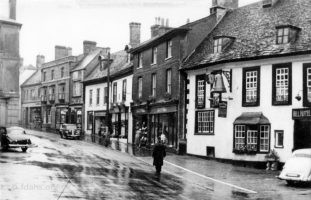 1953. Crossing over and looking towards the start of London Street, #11-12 Market Place to the left of The Bell was Noel Wilkes’ ladies and gents outfitters. Then going up London Street are Frank Thair’s boot and shoe shop, W.H. Smith’s paper shop, Shenton’s sweet shop, a private house, and Chamberlain’s grocery shop.
1953. Crossing over and looking towards the start of London Street, #11-12 Market Place to the left of The Bell was Noel Wilkes’ ladies and gents outfitters. Then going up London Street are Frank Thair’s boot and shoe shop, W.H. Smith’s paper shop, Shenton’s sweet shop, a private house, and Chamberlain’s grocery shop.
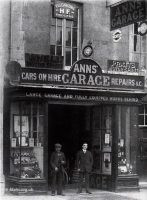
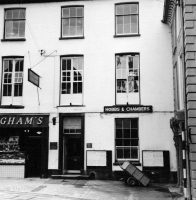 1912 & 1970s – #16. The Anns family had been, since at least 1824, ironmongers, gun retailers and repairers in London Street. At the arrival of the car in the early 1900s, they set up a garage at #16 Market Place, next to Pocock’s Corner. Following this they bought Mr Newman’s blacksmiths shop #22 across the road (see below). Left to right Harry Robins, head mechanic; Edgar Argent, apprentice. It became Tuckers Greengrocer, then between 1950s-1970s the shop was split into two, with Langham’s (greengrocers) on the left and Hobbs & Chambers (estate agents) to the right.
1912 & 1970s – #16. The Anns family had been, since at least 1824, ironmongers, gun retailers and repairers in London Street. At the arrival of the car in the early 1900s, they set up a garage at #16 Market Place, next to Pocock’s Corner. Following this they bought Mr Newman’s blacksmiths shop #22 across the road (see below). Left to right Harry Robins, head mechanic; Edgar Argent, apprentice. It became Tuckers Greengrocer, then between 1950s-1970s the shop was split into two, with Langham’s (greengrocers) on the left and Hobbs & Chambers (estate agents) to the right.
c1920, 1960s & 1970s – #18 Mr Harry Abel outside his watchmaker and jewellery shop. Abel Bros had owned a shop in the Market Place from at least 1877. It was taken over by Leverton & Sons who also had a radio & TV shop up the road in the Cornmarket. During the 1970s it became Deacon & Sons. It remained a jewellers’ shop throughout and the frontage has remained largely unchanged until its closure in 2018. It has now been vacant for some time.
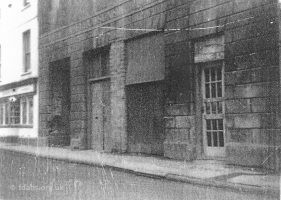
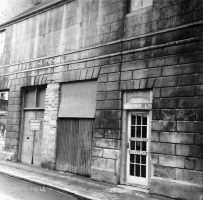 Possibly 1940-70s. On the left is #18, which was Leverton’s Jewellers at this time. Next door is the original frontage of #19 Market Place, which at this time was occupied by Ferguson’s Wine & Spirit Merchants. The building was originally part of Eagle Brewery, which was run by various companies – Fairthorne & Co. were there in the 1890s and W.G.Phillips & Sons in the early 1900s (?). Belcher & Habgood’s off-licence was there in 1902. In 1963 the frontage was extensively damaged when an articulated lorry went out of control and hit the building. Customers had to be served through a window as the doorway had to be boarded up as it was in danger of collapsing. The building appears to be an early 17th C. barn-type construction with an early window in the east gable covered by the jeweller’s premises. Also, as the roof of the jeweller’s shop rests on a tree trunk inserted into the east gable wall, it is likely that it is of a later period.
Possibly 1940-70s. On the left is #18, which was Leverton’s Jewellers at this time. Next door is the original frontage of #19 Market Place, which at this time was occupied by Ferguson’s Wine & Spirit Merchants. The building was originally part of Eagle Brewery, which was run by various companies – Fairthorne & Co. were there in the 1890s and W.G.Phillips & Sons in the early 1900s (?). Belcher & Habgood’s off-licence was there in 1902. In 1963 the frontage was extensively damaged when an articulated lorry went out of control and hit the building. Customers had to be served through a window as the doorway had to be boarded up as it was in danger of collapsing. The building appears to be an early 17th C. barn-type construction with an early window in the east gable covered by the jeweller’s premises. Also, as the roof of the jeweller’s shop rests on a tree trunk inserted into the east gable wall, it is likely that it is of a later period.
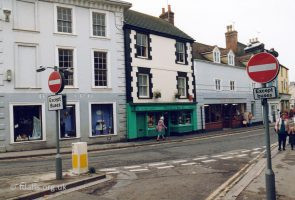 c1970s – #17 Ballard & Co (chemists) 1949-70s, now Boots. #18 Deacon & Sons (jewellers). Next door, the rather old Ferguson’s building at #19 shown above has now been renovated and taken over by ‘Togs & Toys’. By 2000 it was split into two smaller shops – ‘Mustard Seed’ and ‘Rob the Cheese’. The road here becomes very narrow and has become known to local people as ‘The Narrows’.
c1970s – #17 Ballard & Co (chemists) 1949-70s, now Boots. #18 Deacon & Sons (jewellers). Next door, the rather old Ferguson’s building at #19 shown above has now been renovated and taken over by ‘Togs & Toys’. By 2000 it was split into two smaller shops – ‘Mustard Seed’ and ‘Rob the Cheese’. The road here becomes very narrow and has become known to local people as ‘The Narrows’.
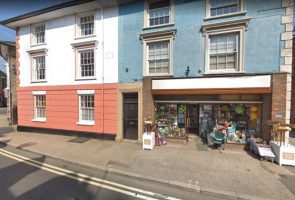 Crossing the narrow road, the first property is #20 ‘Linden House’, formerly called ‘The Lindens’ but no doubt it got confused with the large mansion of that name in Gravel Walk. From the early 1900s to his death in 1954, it was the home of Frank Liddiard (1867-1954). At that time there was a very large garden at the rear with a nut walk, vast walled vegetable garden, a large greenhouse with a vine and a lawn up to the rear of the house. Since the late 19th century, the Liddiard family had owned a grocery, wholesale tobacconist and general store at #7 Market Place but Frank split from his father and brother (both named George) and set up his own business as a grocer and provisions dealer next door here at #21 until he retired, probably around 1927 at the age of 60.
Crossing the narrow road, the first property is #20 ‘Linden House’, formerly called ‘The Lindens’ but no doubt it got confused with the large mansion of that name in Gravel Walk. From the early 1900s to his death in 1954, it was the home of Frank Liddiard (1867-1954). At that time there was a very large garden at the rear with a nut walk, vast walled vegetable garden, a large greenhouse with a vine and a lawn up to the rear of the house. Since the late 19th century, the Liddiard family had owned a grocery, wholesale tobacconist and general store at #7 Market Place but Frank split from his father and brother (both named George) and set up his own business as a grocer and provisions dealer next door here at #21 until he retired, probably around 1927 at the age of 60.
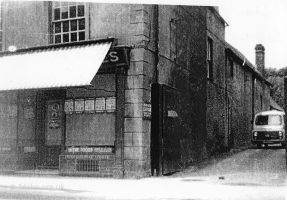 1940’s. At this time #21 was occupied by The International Stores after they had moved from #4 Corn Market in the 1920’s when Frank Liddiard retired from his grocery business here. They remained at this location until at least the 1960’s when it became a bargains shop.
1940’s. At this time #21 was occupied by The International Stores after they had moved from #4 Corn Market in the 1920’s when Frank Liddiard retired from his grocery business here. They remained at this location until at least the 1960’s when it became a bargains shop.
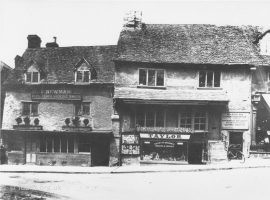 c1908 – On the left is #22, dated 1645, then run by Joseph Newman, blacksmith, who had been here from at least 1877. His forge was at the rear of the house and horses had to be taken through the passageway on the right. On the right is #23 Taylor’s, a greengrocer’s, and a member of the fishmonger and butcher family. The large board, by the window, is covered in photographs taken by Mr E. Haworth of Gloucester Street, Faringdon’s leading photographer. The door on the right has a harness maker’s sign over it.
c1908 – On the left is #22, dated 1645, then run by Joseph Newman, blacksmith, who had been here from at least 1877. His forge was at the rear of the house and horses had to be taken through the passageway on the right. On the right is #23 Taylor’s, a greengrocer’s, and a member of the fishmonger and butcher family. The large board, by the window, is covered in photographs taken by Mr E. Haworth of Gloucester Street, Faringdon’s leading photographer. The door on the right has a harness maker’s sign over it.
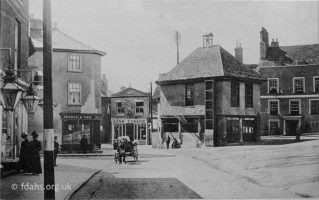
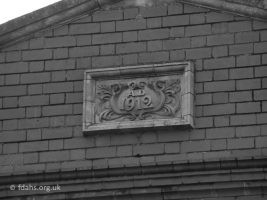 1913. On the left, standing under the gas street lamps are two ladies window shopping at F.W. Creese’s drapery. On the corner is the large bell hanging outside the Bell Hotel. Across the start of Southampton Street is Pocock’s Corner (tailors). Next is #22 Anns’ Garage. This photo was taken just after it had been demolished and rebuilt as a garage by the Anns family in 1912. It became a newsagents in the late 1960s or early 1970s, and has been under four different names since then. The Market Hall in the centre had become the Ambulance & Fire Station at this time. On the far right is part of the Old Crown Coaching Inn.
1913. On the left, standing under the gas street lamps are two ladies window shopping at F.W. Creese’s drapery. On the corner is the large bell hanging outside the Bell Hotel. Across the start of Southampton Street is Pocock’s Corner (tailors). Next is #22 Anns’ Garage. This photo was taken just after it had been demolished and rebuilt as a garage by the Anns family in 1912. It became a newsagents in the late 1960s or early 1970s, and has been under four different names since then. The Market Hall in the centre had become the Ambulance & Fire Station at this time. On the far right is part of the Old Crown Coaching Inn.
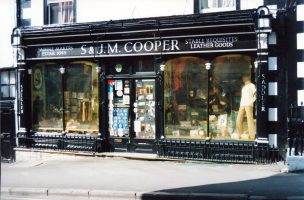 First photo, early 1930s – #23 now taken over by R.A. Robey, who sold vegetables and dairy produce. The shop was taken over by Jane’s Pantry during WWII and stayed until the 1960s. Next door, #24 with the awning was built in the 1600’s, occupant unknown. Second photo c1970 – #24 Burgess (saddler). Last two photos above 1995 & 2000 – #23 became Restaurante Franco, Herbs Restaurant, then Sadlers Catering since around 2014 and #24 became S&J.M Cooper (Sadler) until 2003. It has now been The Sadlers (coffee shop/curiosities) since around 2014. Next door is The Old Crown Coaching Inn as it is now called.
First photo, early 1930s – #23 now taken over by R.A. Robey, who sold vegetables and dairy produce. The shop was taken over by Jane’s Pantry during WWII and stayed until the 1960s. Next door, #24 with the awning was built in the 1600’s, occupant unknown. Second photo c1970 – #24 Burgess (saddler). Last two photos above 1995 & 2000 – #23 became Restaurante Franco, Herbs Restaurant, then Sadlers Catering since around 2014 and #24 became S&J.M Cooper (Sadler) until 2003. It has now been The Sadlers (coffee shop/curiosities) since around 2014. Next door is The Old Crown Coaching Inn as it is now called.
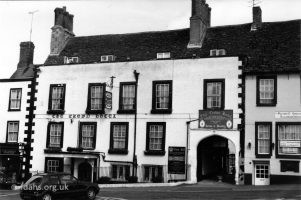
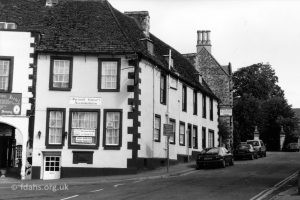
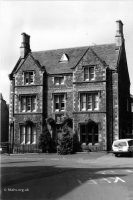 1994 The Crown Hotel a Grade 2 listed, 16C coaching inn, re-fronted in Georgian times. This was the chief inn in Faringdon as far back as 1681. Then as we round the corner and head up Church Street there is the Portwell House Hotel, and Camden House. Compare the architecture with the buildings on the opposite side of the street shown in the first photo at top of this page.
1994 The Crown Hotel a Grade 2 listed, 16C coaching inn, re-fronted in Georgian times. This was the chief inn in Faringdon as far back as 1681. Then as we round the corner and head up Church Street there is the Portwell House Hotel, and Camden House. Compare the architecture with the buildings on the opposite side of the street shown in the first photo at top of this page.
